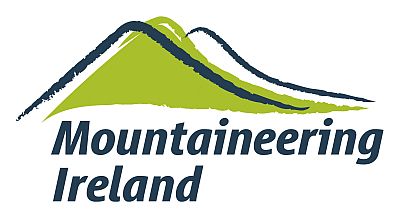
Scrambling is a true form of mountaineering; tackling a mountain straight on, overcoming any obstacles, working as a team and using whatever techniques and equipment are needed to get you to the summit and back.
It's also a grey area and potentially dangerous.
Are you hill walking or are you rock climbing?
If you slip how far will you fall?
Should you be using a rope?
Are you placing gear and pitching or are you moving together on a rope?
In Ireland, especially Kerry and Cork, the rock is loose and fragile; not the kind of rock you want to be trusting if you do slip, yet sometimes that's all you have and you have to adopt a 'sure it's better than nothing' attitude, which is far from ideal.
Over the coming weeks I'm going to add to this blog post dealing with some of the many considerations when scrambling.
I'm not writing this as a manual to go into the mountains and try out for the first time, but rather as a backup resource if you've already done a
Scrambling Course with us.
What I'm writing about can't be properly absorbed from reading this, but needs to be absorbed through doing one of our training courses or going through an apprenticeship with experienced mountaineers.
ApproachDevelop Mountain Sixth Sense:through hill walking in all kinds of mountain terrain, in all kinds of weather, at all times of year.
Click here to read more on thisTurn Back Early:from your planned route, or look for different options, if you feel you're stepping out of your comfort zone, you're beginning to lose control of your situation, or the weather and mountain conditions are worsting.
Be Prepared:for most eventualities in the Irish mountains, so a minor incident such as a map blowing away or someone getting cold and wet can be quickly dealt with.
Click here to read more on thisKnow Your Route:through asking local experienced mountaineers firstly, then check guide books and the internet. Find out where it starts and finishes, what the tricky sections are like, any major hazards and your location on the mountain when you reach the top of the scramble.
Look For Your Route:on your approach walk as you'll probably have an overall birds-eye view of the mountainside.
Use this time to look at different routes up your scramble, different ramps that you could link together, any areas to avoid. Look for the easiest and safest descent route, in case you need to make an emergency descent for some reason.
Moving Across Steep GroundVisually Check:the ground as you move across it. Are there loose pieces to avoid? Are there solid pieces to use? Does it look slippery? Most importantly look at the rocks you’re scrambling over. Even though they’re big or may look solid, how well are they connected to the mountainside?
Kick Each Foot Placement:before you place your full body weight onto it. This will test for looseness and a solid kick will also bond your foot more securely to the ground.
Bang Each Hand Placement:before you place your full body weight on it. This will test for looseness. You want to feel for any wobbles or vibrations and also look for any vibrations.
Three Points Of Contact:should be made with the mountain if you’re scrambling steeply. You’ve four contact points altogether; two feet and two hands. Only move one contact point at a time, so if you slip you’ve three secure points holding you to the mountain.
Think About The Likelihood:of a slip before you make each tricky move. Is the likelihood of slipping low, medium or high? Obviously the higher the likelihood of slipping, the more precautions you need to take.
Think About The Consequences:of a slip before you make each tricky move. Are the consequences of slipping low, medium or high? Low consequences being a slither down some scree or a banged knee and high consequences being a serious fall or falling backwards. Obviously the higher the likelihood of slipping, the more precautions you need to take.
Combine Likelihood & Consequences:
to make an informed and safe decision. If you’ve low likelihood of a slip combined with medium consequences then it's probably safe for you to do. If you’ve medium likelihood of a slip combined with medium or high consequences then it’s not safe for you to do.
Never Lunge, Grab Or Throw Your Weight:onto a handhold or foot placement because while that handhold may support your weight when used carefully; by shock loading it you put it under much more strain.
Careful, Balanced & Delicate Moves:using small steps and short reaches, to ensure you’re never off balance or throwing your weight onto anything. This is especially important when descending.
Excellent Communication:with all party members, so if you touch a loose rock or step on a slippery slope, everyone else learns from your mistake and no-one else puts themselves at risk.
Look For Safe Havens:that you can aim for, recover your breath, take a drink and re-assess your route. These aren’t things you want to be doing part way up a tricky section, where you will need full concentration on simply moving safely.
Difficult GroundNever Scramble Up:something you can't safely scramble back down again. Before you climb up or across a step ensure you're happy to climb back down or across the same step, if you need to retrace your route.
Zoom Out:and look at the bigger picture if you begin to feel trapped or in danger. Often if you take a minute to look around you there is an easier, safer option nearby, that you just haven't spotted.
Scout Ahead:if the route becomes complicated. Instead of the whole party wandering around on steep ground send two members slightly ahead to scout out if there's a safe route or not.
Secondary Drops:need to be watched out for. There may only be a minor drop from the little ledge you're standing on, but is there a secondary drop slightly lower down that you may also tumble over, if you were to slip?
Fall Lines:need to also be watched out for. Look at what direction you would slip and by weaving through boulders try to put obstacles in the way of your fall direction. If you were to slip these obstacles will stop you from tumbling.
Say No:and look for another option, take your time to scout ahead or even turn around and re-trace your steps back to your car if need be. The best and safest decision you'll ever make in the hills is to turn around!
Don't Be Under Pressure:from yourself or from other party members. If you do ever feel under pressure or think you shouldn't really be in that situation, then find a safe haven, stop, relax for five mins, have a cup of tea or chocolate bar and carefully re-assess.
Always Be Warm, Dry, Watered & Fed:You make much better decisions when you're warm and dry. Even more importantly you need to be fully hydrated and full of energy so drink and eat throughout your day. To that end use a platypus and fill your pockets with snacks.
If You Get Stuck:don't take chances. Stop, re-assess and if really necessary call for help. Don't take dangerous chances to get yourself out of difficulty. Are you sure you're really stuck though? Really think about the above two points.
Next week I'll look at when you think about using a rope in a minor emergency...
 Click here to book onto a Scrambling Course!
Click here to book onto a Scrambling Course!Please leave your comments or suggestions below.
Have I missed out on anything? Just add in the comments section.
.JPG)




















.JPG)



















